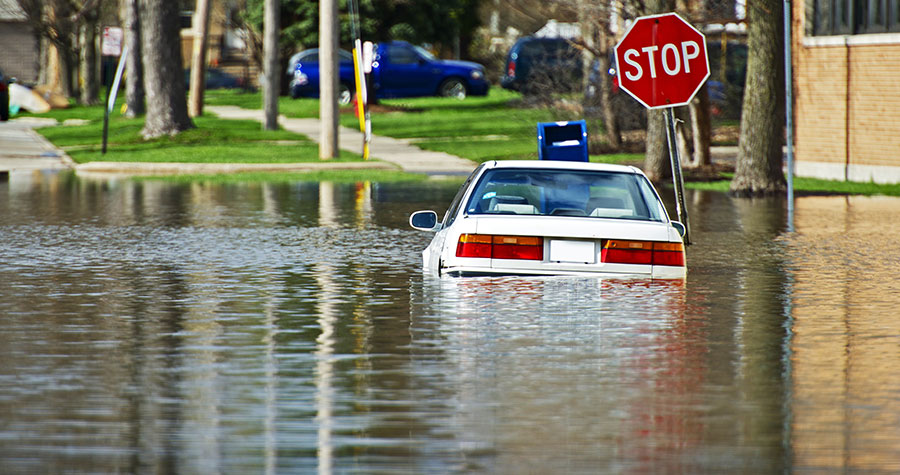Terms to Know
Flash Flood or Flood Watch
Indicates flash flooding or flooding is possible within the designated watch area. When a watch is issued, be alert and ready to take action.
Flash Flood or Flood Warning
Flash flooding or flooding has been reported or is imminent. You should take necessary precautions and actions at once.
Act Now to be Prepared
- Learn the safest route from your home or business to high, safe ground should you have to leave in a hurry.
- Develop and practice a “family escape” plan and identify a meeting place if family members become separated.
- Make an itemized list of all valuables including furnishings, clothing and other personal property. Keep the list in a safe place.
- Stockpile emergency supplies of canned food, medicine and first aid supplies and drinking water. Store drinking water in clean, closed containers.
- Plan what to do with your pets.
- Have a portable radio, flashlights, extra batteries and emergency cooking equipment available.
- Keep your automobile fueled. If electric power is cut off, gasoline stations may not be able to pump fuel for several days. Have a small disaster supply kit in the trunk of your car.
- Find out how many feet your property is above and below possible flood levels. When predicted flood levels are broadcast, you can determine if you may be flooded.
- Keep materials like sandbags, plywood, plastic sheeting and lumber handy for emergency water-proofing.
During the Flood
- Monitor the National Oceanic & Atmospheric Administration’s (NOAA) Weather Radio or your local radio and TV station broadcasts for information.
- If local officials advise evacuation, do so promptly.
- If directed to a specific location, go there.
- Know where the shelters are located.
- Bring outside possessions inside the house or tie them down securely. This includes lawn furniture, garbage cans, and other movable objects.
- If there is time, move essential items and furniture to upper floors in the house. Disconnect electrical appliances that cannot be moved. DO NOT touch them if you are wet or standing in water.
- If you are told to shut off water, gas, or electrical services before leaving, do so.
- Secure your home: lock all doors and windows.
Travel with Care
- Leave early to avoid being marooned on flooded roads.
- Make sure you have enough fuel for your car.
- Follow recommended routes. DO NOT sightsee.
- As you travel, monitor NOAA Weather Radio and local radio broadcasts for the latest information.
- Watch for washed-out roads, earth-slides, broken water or sewer mains, loose or downed electrical wires, and falling or fallen objects.
- Watch for areas where rivers or streams may suddenly rise and flood, such as highway dips, bridges, and low areas.
- DO NOT attempt to drive over a flooded road. Turn around and go another way.
- DO NOT underestimate the destructive power of fast-moving water. Two feet of fast-moving flood water will float your car. Water moving at two miles per hour can sweep cars off a road or bridge.
- If you are in your car and water begins to rise rapidly around you, abandon the vehicle immediately.
After the Flood
- Listen to the radio or TV for instructions from local officials.
- Wait until an area has been declared safe before entering it. Be careful driving, since roads may be damaged and power lines may be down.
- Before entering a building, check for structural damage. Turn off any outside gas lines at the meter or tank. Let the building air out to remove foul odors or escaping gas.
- Upon entering the building, use a battery-powered flashlight. DO NOT use an open flame as a source of light. Gas may be trapped inside.
- When inspecting the building, wear rubber boots and gloves.
- Watch for electrical shorts and live wires before making certain the main power switch is off.
- DO NOT turn on electrical appliances until an electrician has checked the system and appliances.
- Throw out any medicine or food that has had contact with flood waters.
- Test drinking water for portability. Wells should be pumped out and water tested for drinking.
- If the public water system is declared “unsafe” by health officials, water for drinking and cooking should be boiled vigorously for 10 minutes.
- Shovel out mud with special attention to cleaning heating and plumbing systems.
- Flooded basements should be drained and cleaned as soon as possible. Structural damage can occur if drained too quickly. When surrounding waters have subsided, begin draining the basement in stages, about 1/3 of the water volume each day.

